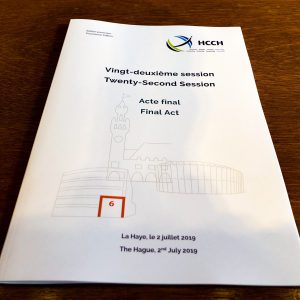Conclusion of the HCCH Judgments Convention: The objectives and architecture of the Judgments Convention, a brief overview of some key provisions, and what’s next?
Prepared by Cara North, external consultant to the Permanent Bureau of the Hague Conference on Private International Law (HCCH). This post reflects only personal views.
Today marks a momentous occasion (in the private international law world at least): the conclusion of the Diplomatic Session on the HCCH Convention on the Recognition and Enforcement of Foreign Judgments in Civil or Commercial Matters (“Judgments Convention”). A Convention that, as noted by the Secretary General of the Hague Conference on Private International Law (“HCCH”) during his opening remarks for the Session, will be a “gamechanger for cross-border dispute settlement and an apex stone for global efforts to improve real and effective access to justice.”
The origins of the Judgments Convention date back to the early 1990s with a proposal from the United States of America for a mixed convention dealing with the exercise of jurisdiction and the recognition and enforcement of foreign judgments. After many years of hard work on a draft instrument, it was decided that such an instrument was indeed too ambitious, and it was preferable for the HCCH to focus on more specific projects that fell within the remit of that work. The HCCH refocussed its energies on an instrument concerning exclusive choice of court agreements and, with the benefit of the hard work undertaken in the early 1990s, the Convention on Choice of Court Agreements (“Choice of Court Convention”) was concluded in 2005. That Convention entered in to force in 2015 with Mexico and the European Union becoming Contracting Parties. Since then, Singapore and Montenegro have followed suit and a few other States have either signed the Convention or otherwise indicated their intention to become party to the Convention.
Following the successful conclusion of the Choice of Court Convention, the HCCH once again took stock of potential future projects. In 2012, the train was set in motion for work and negotiations on the Judgments Convention to commence. At first it was decided that the work on the recognition and enforcement of foreign judgments would be undertaken alongside work on regulating international jurisdiction in civil or commercial matters. However, it was then decided that work would first proceed on drafting an instrument on the recognition and enforcement of judgments, with work on international jurisdiction to follow thereafter.
Some seven years and many meetings later, the Judgments Convention has been concluded. Sharing in the enthusiasm for this long-standing project Uruguay signed the Convention today.
The Objectives and Architecture of the Judgments Convention
Broadly speaking, like the Choice of Court Convention, the objectives of the Judgments Convention are (i) enhancing access to justice and (ii) facilitating cross-border trade and investment by reducing the costs and risks associated with cross-border dealings.
Building on the hard work undertaken in the early 2000s to complete the Choice of Court Convention and with the intention of the Judgments Convention operating as a sister instrument to the Choice of Court Convention, the Judgments Convention took, where appropriate, the basic structure and provisions of the Choice of Court Convention as its starting point. The working method adopted was to depart from the provisions of the Choice of Court Convention only where there was good reason to do so.
With that basic structure and working method in mind, work then focussed on the circumstances in which it would be largely uncontroversial for a civil or commercial judgment rendered in the courts of one Contracting State to be recognised and enforced in the courts of another Contracting State.
A comprehensive overview of the provisions in the Judgments Convention will be found in the forthcoming Explanatory Report to the Judgments Convention. This blog post serves to highlight just some of the key provisions.
A Brief Overview of Some Key Provisions
The Convention is separated into four chapters. Chapter I concerns the scope and definitions. Articles 1 and 2 provide the scope of the Convention (i.e., civil or commercial matters) and Article 2 of the Convention provides a number of exclusions from scope. In some respects, these exclusions mirror the exclusions found in the Choice of Court Convention. There are, however, some notable differences including the exclusion of privacy matters and the exclusion of intellectual property matters (a topic which was the subject of a considerable amount of consultation and discussion), as well as some notable inclusions such as certain tort matters, judgments ruling on rights in rem in immovable property and tenancies of immovable property as well as a very limited number of anti-trust (competition) law matters (emphasis added). Article 3 provides a number of important definitions, including the definition of “judgment”. The Convention provides for the circulation of final judgments, this includes both money and non-money judgments. This is of particular importance because while some jurisdictions recognise and enforce money judgments under national law, the traditional approach under others (e.g., under the common law system) is to decline to enforce non-money judgments.
Chapter II contains several core provisions. Most importantly, it identifies the judgments that are eligible for recognition and enforcement and sets out the process for the recognition and enforcement of those judgments. In this respect, Article 4 contains the core obligation under the Convention. It provides that “a judgment given by a court of a Contracting State shall be recognised and enforced in another Contracting State in accordance with [Chapter 2 of the Convention].” Article 5 then sets out the categories of judgments that are eligible for recognition and enforcement. It contains an exhaustive list of indirect grounds of jurisdiction. These grounds fall into three broad categories based on (i) the connection between the State of origin and the defendant (e.g., habitual residence in the State of origin), (ii) jurisdiction based on consent (e.g., express consent to the court of origin in the course of proceedings) or (iii) a connection between the claim and the State of origin (e.g., place of performance of the contract). Some of these grounds are commonly found in regional instruments concerning the recognition and enforcement of judgments in civil or commercial matters and/or are under the national law of many jurisdictions, for other jurisdictions the provisions will significantly broaden the basis on which courts will be obliged to recognise and enforce foreign judgments. At this juncture, it should be noted that the Convention, with one exception, does not limit recognition and enforcement under national law in any way. Article 15 of the Convention provides that, subject to Article 6, the Convention does not prevent the recognition or enforcement of judgments under national law. Article 6 contains one exclusive basis of jurisdiction concerning rights in rem in immovable property. It provides that where a judgment ruled on rights in rem in immovable property, that judgment will be recognised and enforced under the Convention if and only if the State of origin is the State in which the property is situated. Article 7(1) contains the specific grounds on which recognition or enforcement may be refused. There are two categories of grounds (i) based on the way the proceedings took place in the State of origin (e.g., improper notice); or (ii) based on the nature and content of the judgment (e.g., where the judgment is inconsistent with a judgment given by a court of the State in which enforcement is sought).
Articles 8 to 11 provide for specific issues concerning the interpretation and application of the Convention and Articles 12 to 14 concern the process for recognition and enforcement of judgments under the Convention and largely mirror the relevant Choice of Court Convention provisions. As noted above, Article 15 – the last Article in Chapter II – is an important provision in that it cements the basic premise of the Judgments Convention i.e., that it sets the minimum standards for the recognition and enforcement of judgments among Contracting States.
Chapter III deals with general clauses and importantly includes a number of permissible declarations such as (i) declarations with respect to specific matters (Article 18) which enables a State to declare that it will not apply the Convention to a specific matter where that State has a strong interest in doing so (the same provision is found in Article 21 of the Choice of Court Convention); and (ii) declarations with respect to judgments pertaining to States (Article 19). Article 19 enables a State to make a declaration excluding the application of the Convention to judgments which arose from proceedings to which a State was a party, even where the judgment relates to civil or commercial matters.
Finally, Chapter IV of the Convention deals with final clauses, which concern important matters such as the process for ratification of the Convention and the establishment of treaty relations between Contracting States.
What’s next?
With the successful conclusion of the Judgments Convention, the HCCH can once again look to future projects in the area of international civil and commercial litigation. So, what’s next for the work programme of the HCCH in this space?
First, the HCCH is set to resume work on matters relating to jurisdiction. The 2019 Conclusions and Recommendations following the meeting of the Council on General Affairs and Policy (the governing body that sets the work programme of the HCCH) provide that in February 2020 the Experts’ Group will resume its work “addressing matters relating to jurisdiction with a view to preparing an additional instrument”.
Second, as a decision was made to exclude intellectual property matters from the scope of the Convention, the Diplomatic Session invited “the Council on General Affairs and Policy to consider, at its 2020 meeting, what, if any, further work it wishes the HCCH to undertake on the intersection between private international law and intellectual property”. This decision was recorded in the Final Act of the Judgments Convention.
Decades since work commenced in this area, the conclusion of the Judgments Convention is a significant milestone for the HCCH. But more importantly, with the exponential growth in international trade since the commencement of the Judgments Project, and the consequential corresponding increase in the number of transnational commercial disputes, it is now more important than ever for parties engaged in cross-border disputes to have effective access to justice. Once widely ratified, the Convention will go a long way toward enhancing access to justice and facilitating cross-border trade and investment.

